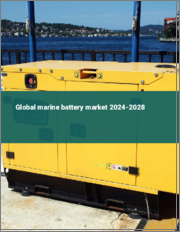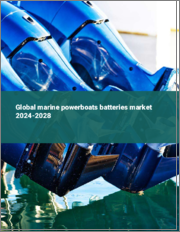
|
시장보고서
상품코드
1714196
세계의 선박용 배터리 시장 평가 : 유형별, 기능별, 용량별, 용도별, 지역별, 기회 및 예측(2018-2032년)Marine Battery Market Assessment, By Type, By Function, By Capacity, By Application, By Region, Opportunities and Forecast, 2018-2032F |
||||||
세계 선박용 배터리 시장 규모는 2024년 14억 6,000만 달러에서 2032년 37억 7,000만 달러에 달할 것으로 예상되며, 2025-2032년 예측 기간 동안 CAGR 12.64%로 성장할 것으로 예상됩니다. 선박의 첨단화에 따라 전력 공급도 다양화되고 있습니다. 업계는 안전, 에너지 밀도, 배터리의 전반적인 수명을 중요시하고 있습니다. 국제해사기구(International Maritime Organization, IMO) 등이 정한 황 배출 억제에 대한 요구사항을 준수해야 하는 선박 소유주들은 이러한 환경적 지속가능성에 대한 요구가 높아짐에 따라 선박 추진 부문에 부정적인 영향을 미치고 있습니다. 리튬이온 배터리와 전고체 배터리가 주도하는 가운데, 납축배터리의 AGM(Absorbed Glass Mat) 기술과 젤 기술의 새로운 기술도 충전 속도와 내구성을 향상시키고 있습니다.
예를 들어, 2023년 7월, GS Yuasa Battery Sales UK Ltd.는 선박용 듀얼 AGM 배터리를 출시하였습니다. 이 시리즈에는 M24-AGM과 M28-AGM이 있으며, 엔진 시동, 내비게이션, 라디오, GPS, 조명과 같은 중요한 선상 장비의 원활한 작동을 보장하면서 안정적인 시동 전원을 공급하도록 특별히 설계되었습니다. 이 첨단 배터리는 시동 전원과 보조 전원 모두에 대한 요구를 충족시키며, 최대 사이클 수, 짧은 충전 시간, 자기 방전 감소로 인한 긴 저장 기간을 제공합니다.
세계의 선박용 배터리 시장에 대해 조사 분석했으며, 시장 규모와 예측, 시장 역학, 주요 기업 개요 등의 정보를 전해드립니다.
목차
제1장 프로젝트 범위와 정의
제2장 조사 방법
제3장 미국 관세의 영향
제4장 주요 요약
제5장 고객의 소리
- 제품과 시장 정보
- 브랜드 인지도
- 구입 결정에서 고려되는 요소
- 용도와 전력 요건
- 배터리 유형과 기술
- 유지보수 요건
- 규제 검토
제6장 세계의 선박용 배터리 시장 전망(2018-2032년)
- 시장 규모 분석과 예측
- 금액
- 시장 점유율 분석과 예측
- 유형별
- 리튬
- 나트륨 이온
- 니켈 카드뮴
- 납축배터리
- 연료전지
- 기능별
- 시동
- 딥 사이클
- 이중 목적
- 용량별
- 100Ah 미만
- 100-250Ah
- 250Ah 이상
- 용도별
- 상선
- 군함
- 무인 해상선
- 지역별
- 북미
- 유럽
- 아시아태평양
- 기타 지역
- 시장 점유율 분석 : 기업별(금액)(상위 5개사와 기타 - 2024년)
- 유형별
- 시장 맵 분석(2024년)
- 유형별
- 기능별
- 용량별
- 용도별
- 지역별
제7장 북미의 선박용 배터리 시장 전망(2018-2032년)
- 시장 규모 분석과 예측
- 유형별
- 리튬
- 나트륨 이온
- 니켈 카드뮴
- 납축배터리
- 연료전지
- 기능별
- 시동
- 딥 사이클
- 이중 목적
- 용량별
- 100 Ah 미만
- 100-250Ah
- 250 Ah초
- 용도별
- 상선
- 군함
- 무인 해상선
- 점유율 : 국가별
- 미국
- 캐나다
- 유형별
- 각국의 시장 평가
- 미국의 선박용 배터리 시장 전망(2018-2032년)
- 시장 규모 분석과 예측
- 시장 점유율 분석과 예측
- 캐나다
- 미국의 선박용 배터리 시장 전망(2018-2032년)
제8장 유럽의 선박용 배터리 시장 전망(2018-2032년)
- 독일
- 프랑스
- 이탈리아
- 영국
- 러시아
- 기타 유럽
제9장 아시아태평양의 선박용 배터리 시장 전망(2018-2032년)
- 인도
- 중국
- 일본
- 호주
- 기타 아시아태평양
제10장 기타 지역의 선박용 배터리 시장 전망(2018-2032년)
- 남미
- 중동 및 아프리카
제11장 수급 분석
제12장 밸류체인 분석
제13장 Porter's Five Forces 분석
제14장 PESTLE 분석
제15장 시장 역학
- 시장 성장 촉진요인
- 시장 과제
제16장 시장 동향과 발전
제17장 정책과 규제 상황
제18장 사례 연구
제19장 경쟁 구도
- 시장 리더 상위 5개사 경쟁 매트릭스
- 상위 5개사 SWOT 분석
- 주요 기업 상위 10개사 상황
- EnerSys
- Toshiba Corporation
- Siemens Energy AG
- Leclanche SA
- Saft Groupe SAS
- Echandia Marine AB
- EverExceed Corporation
- Lifeline Batteries Inc.
- Sensata Technologies, Inc.
- OPTIMA Batteries(CLARIOS, LLC)
제20장 전략적 제안
제21장 조사 회사 소개 및 면책사항
ksm 25.05.14Marine battery market is projected to witness a CAGR of 12.64% during the forecast period 2025-2032, growing from USD 1.46 billion in 2024 to USD 3.77 billion in 2032F owing to the increased electrification of these marine vessels. As these vessels become more high-tech, power sourcing has also diversified. The industry focuses on safety, energy density, and the overall lifespan of the battery. This growing trend toward environmental sustainability has adversely affected the ship propulsion sector since shipowners have to comply with increasingly stringent requirements for control of sulfur emissions set by organizations such as the International Maritime Organization. While lithium-ion and solid-state batteries lead the way, the new innovations in Absorbed Glass Mat (AGM) and Gel technologies within lead-acid batteries are also improving charging speed and durability.
For instance, in July 2023, GS Yuasa Battery Sales UK Ltd. launched marine dual AGM battery range. The range includes the M24-AGM and M28-AGM, specifically designed to provide stable starting power while ensuring smooth operation of critical onboard equipment, including engine start, navigation, radio, GPS, and lighting. These advanced batteries address both starting and auxiliary power needs, providing the maximum number of cycles, quicker charging times, and reduced self-discharge for prolonged shelf life.
Fleet Electrification Due to Decarbonization Drives the Marine Battery Market
The rising fuel prices have led governments, private vessel operators, and logistics companies to switch to hybrid propulsion or electric ships. This trend is also followed by the global decarbonization process that comprises adoption of alternative energy such as electrical or hydrogen fuel cells. With more stringent environmental regulations, such as the IMO's sulfur emission limits, shipowners are being forced to adopt cleaner propulsion systems.
The transition for cleaner propulsion systems has triggered a demand for marine batteries in hybrid and fully electric vessels. Furthermore, the technological advancements comprising constant development in lithium-ion and solid-state batteries along with faster charging and higher energy density also shape the market dynamics. Hence, the companies working for green energy and decarbonization are expanding their presence in marine, aircraft, or vehicle battery market.
For instance, in October 2024, Fortescue Metal Group unveiled a marine battery manufacturing plant in United States. The company commenced operations at its 38,000-square-meter Advanced Manufacturing Centre located in Michigan, United States, by manufacturing marine battery packs that utilize its scalable battery module (SBM) technology.
Expansion of Electric Vessels due to Supportive Regulatory Framework to Shape the Global Market
The rising adoption of hybrid and electric vessels propels market growth along with higher investments in the commercial and defense sectors. The trend upscales through these sectors focusing on lower reliance on fossil fuel. The companies producing marine batteries are focusing on the environmental conditions, usage patterns, technological advancements, and the major operational factors.
These trends across sectors are supported by governments around the globe. The overall development and adoption of marine batteries is being greatly encouraged by the energizing policies and incentives of governments. These all include subsidies, grants, and friendly regulations that encourage investment in battery technologies by shipbuilders and operators. The government funds usually are for the overall digitization of ports which includes switching to green fuels as well.
For instance, in February 2024, the Indian government announced a 30% subsidy for hydrogen, and green fuels along with port digitization. This initiative represents a comprehensive strategy for advancing Indian shipping, as revealed by the Indian Ministry of Ports, Shipping & Waterways (MoPSW). In addition, the government has unveiled a plan to modernize the tug fleet, with the goal of beginning the integration of hybrid tugs by 2025. Officials have indicated that by 2030, it is anticipated that at least 50% of all tugs will be transitioned to environmentally friendly operations.
Lithium Segment Leads with Higher Density and Advanced Design
Based on battery type, lithium batteries lead in the marine battery market due to higher energy density and lightweight design. These batteries usually deliver higher energy density, enabling more energy storage than other batteries. Additionally, the lightweight design only adds up to efficiency and performance, reducing overall vessel weight. Lithium-ion batteries are reliable when it comes to the extreme marine requirements as they help the ship in limiting the downtime. These batteries have the capability to achieve this goal through faster charging and minimum energy loss. They can also be integrated with renewable energy sources such as solar panels or wind turbines, which further enhances their sustainability.
For instance, in January 2025, L3Harris Technologies, Inc. provided the initial batch of autonomous undersea vehicles that utilize lithium-ion batteries designed to resist passive propagation, which have been approved for use on submarines in the United States. These rechargeable lithium-ion (Li-ion) batteries allow the Iver4 900 autonomous undersea vehicle (AUV), which can be launched and retrieved via torpedo tubes, to conduct several missions while occupying a minimal amount of space in the torpedo room.
North America leads the Market with a Strong Presence in Marine Industry
North America holds a leading position in the marine battery market, driven by stringent environmental regulations and a strong focus on sustainable maritime practices. The region's commitment to reducing emissions has led to increased adoption of electric and hybrid vessels, particularly in the United States and Canada. Significant investments in research and development, coupled with government incentives, are fostering innovation in battery technologies. North America's advanced marine infrastructure and proactive policies are positioning it as a key player in the global shift towards electrified maritime transportation.
For instance, in February 2025, United State's Solid State Marine announced its series of state-of-the-art batteries that are manufactured in the United States. These come in all standard battery sizes to customers across the region. The patented technology uses a completely solid electrolyte, reducing fire risk and weight while increasing run time and allowing operation in cold temperatures. These batteries are designed to be interchangeable with existing systems, and the company offers a range of products for various marine applications.
Future Market Scenario (2025 - 2032F)
Urban areas are likely to implement electric ferries to reduce pollution and improve public transportation.
Marine batteries are expected to be combined with solar and wind energy systems for sustainable power generation on ships.
Technological advancements comprising faster charging and integration with battery management system are anticipated to lead batteries capable of powering large cargo ships over long distances.
Developing countries invest in marine battery technology to modernize their fleets and comply with
environmental standards.
Key Players Landscape and Outlook
The marine battery market's competitive strategy revolves around innovation, regulatory compliance, and cost-efficiency. Manufacturers focus on developing advanced battery technologies, such as lithium-ion and solid-state batteries, to meet the increasing demand for efficient, lightweight, and high-energy-density solutions. Compliance with stringent environmental regulations drives the adoption of hybrid and fully electric propulsion systems, particularly in emission-controlled zones. Companies invest heavily in R&D to enhance battery performance, lifespan, and safety while integrating smart technologies like Battery Management Systems (BMS) for improved operational efficiency. Market players also target specific segments like commercial vessels and short-range ferries to capitalize on electrification trends.
For instance, in June 2022, Leclanche SA announced its third-generation marine battery system that is going to electrify a broad range of vessels. The Navius MRS-3TM is an advanced version of Leclanche's acclaimed and award-winning MRS-2, which is currently utilized in various ferries, container ships, and specialized vessels. This liquid-cooled system enhances longevity, facilitates a more compact structure, and enables energy density that is up to 50% greater than that of air-cooled systems.
Table of Contents
1. Project Scope and Definitions
2. Research Methodology
3. Impact of U.S. Tariffs
4. Executive Summary
5. Voice of Customers
- 5.1. Product and Market Intelligence
- 5.2. Brand Awareness
- 5.3. Factors Considered in Purchase Decisions
- 5.3.1. Application and Power Requirements
- 5.3.2. Battery Type and Technology
- 5.3.3. Maintenance Requirements
- 5.4. Consideration of Regulations
6. Global Marine Battery Market Outlook, 2018-2032F
- 6.1. Market Size Analysis & Forecast
- 6.1.1. By Value
- 6.2. Market Share Analysis & Forecast
- 6.2.1. By Type
- 6.2.1.1. Lithium
- 6.2.1.2. Sodium-Ion
- 6.2.1.3. Nickel Cadmium
- 6.2.1.4. Lead-Acid
- 6.2.1.5. Fuel Cell
- 6.2.2. By Function
- 6.2.2.1. Starting
- 6.2.2.2. Deep Cycle
- 6.2.2.3. Dual Purpose
- 6.2.3. By Capacity
- 6.2.3.1. <100Ah
- 6.2.3.2. 100-250Ah
- 6.2.3.3. >250Ah
- 6.2.4. By Application
- 6.2.4.1. Commercial Vessels
- 6.2.4.2. Military Vessels
- 6.2.4.3. Unmanned Maritime Vessels
- 6.2.5. By Region
- 6.2.5.1. North America
- 6.2.5.2. Europe
- 6.2.5.3. Asia-Pacific
- 6.2.5.4. Rest of the World
- 6.2.6. By Company Market Share Analysis (Top 5 Companies and Others - By Value, 2024)
- 6.2.1. By Type
- 6.3. Market Map Analysis, 2024
- 6.3.1. By Type
- 6.3.2. By Function
- 6.3.3. By Capacity
- 6.3.4. By Application
- 6.3.5. By Region
7. North America Marine Battery Market Outlook, 2018-2032F
- 7.1. Market Size Analysis & Forecast
- 7.1.1. By Type
- 7.1.1.1. Lithium
- 7.1.1.2. Sodium-Ion
- 7.1.1.3. Nickel Cadmium
- 7.1.1.4. Lead-Acid
- 7.1.1.5. Fuel Cell
- 7.1.2. By Function
- 7.1.2.1. Starting
- 7.1.2.2. Deep Cycle
- 7.1.2.3. Dual Purpose
- 7.1.3. By Capacity
- 7.1.3.1. <100Ah
- 7.1.3.2. 100-250Ah
- 7.1.3.3. >250Ah
- 7.1.4. By Application
- 7.1.4.1. Commercial Vessels
- 7.1.4.2. Military Vessels
- 7.1.4.3. Unmanned Maritime Vessels
- 7.1.5. By Country Share
- 7.1.5.1. United States
- 7.1.5.2. Canada
- 7.1.1. By Type
- 7.2. Country Market Assessment
- 7.2.1. United States Marine Battery Market Outlook, 2018-2032F*
- 7.2.1.1. Market Size Analysis & Forecast
- 7.2.1.1.1. By Value
- 7.2.1.2. Market Share Analysis & Forecast
- 7.2.1.2.1. By Type
- 7.2.1.2.1.1. Lithium
- 7.2.1.2.1.2. Sodium-Ion
- 7.2.1.2.1.3. Nickel Cadmium
- 7.2.1.2.1.4. Lead-Acid
- 7.2.1.2.1.5. Fuel Cell
- 7.2.1.2.2. By Function
- 7.2.1.2.2.1. Starting
- 7.2.1.2.2.2. Deep Cycle
- 7.2.1.2.2.3. Dual Purpose
- 7.2.1.2.3. By Capacity
- 7.2.1.2.3.1. <100Ah
- 7.2.1.2.3.2. 100-250Ah
- 7.2.1.2.3.3. >250Ah
- 7.2.1.2.4. By Application
- 7.2.1.2.4.1. Commercial Vessels
- 7.2.1.2.4.2. Military Vessels
- 7.2.1.2.4.3. Unmanned Maritime Vessels
- 7.2.1.2.1. By Type
- 7.2.1.1. Market Size Analysis & Forecast
- 7.2.2. Canada
- 7.2.1. United States Marine Battery Market Outlook, 2018-2032F*
All segments will be provided for all regions and countries covered
8. Europe Marine Battery Market Outlook, 2018-2032F
- 8.1. Germany
- 8.2. France
- 8.3. Italy
- 8.4. United Kingdom
- 8.5. Russia
- 8.6. Rest of Europe
9. Asia-Pacific Marine Battery Market Outlook, 2018-2032F
- 9.1. India
- 9.2. China
- 9.3. Japan
- 9.4. Australia
- 9.5. Rest of Asia-Pacific
10. Rest of the World Marine Battery Market Outlook, 2018-2032F
- 10.1. South America
- 10.2. Middle East and Africa
11. Demand Supply Analysis
12. Value Chain Analysis
13. Porter's Five Forces Analysis
14. PESTLE Analysis
15. Market Dynamics
- 15.1. Market Drivers
- 15.2. Market Challenges
16. Market Trends and Developments
17. Policy and Regulatory Landscape
18. Case Studies
19. Competitive Landscape
- 19.1. Competition Matrix of Top 5 Market Leaders
- 19.2. SWOT Analysis for Top 5 Players
- 19.3. Key Players Landscape for Top 10 Market Players
- 19.3.1. EnerSys
- 19.3.1.1. Company Details
- 19.3.1.2. Key Management Personnel
- 19.3.1.3. Products and Services
- 19.3.1.4. Financials (As Reported)
- 19.3.1.5. Key Market Focus and Geographical Presence
- 19.3.1.6. Recent Developments/Collaborations/Partnerships/Mergers and Acquisition
- 19.3.2. Toshiba Corporation
- 19.3.3. Siemens Energy AG
- 19.3.4. Leclanche SA
- 19.3.5. Saft Groupe SAS
- 19.3.6. Echandia Marine AB
- 19.3.7. EverExceed Corporation
- 19.3.8. Lifeline Batteries Inc.
- 19.3.9. Sensata Technologies, Inc.
- 19.3.10. OPTIMA Batteries (CLARIOS, LLC)
- 19.3.1. EnerSys
Companies mentioned above DO NOT hold any order as per market share and can be changed as per information available during research work.

















